

SPRING QUARTER, 2006
Department of History
University of California, Irvine
Instructor: Dr. Barbara J. Becker
|
Lecture 3. The Alexandrian Legacy
|
The Alexandrians |
||
(Roman Empire--Greeks) |
||
| Hero | fl. 62 CE | Optics · studied reflection and refraction · constructed automated gadgets |
| Ptolemy | fl. 125 | Astronomy/Cartography · wrote Almagest; The Geography |
| Galen | 131-201 | Medicine · wrote On the Natural Faculties |
The source and purpose of blood, according to Galen:
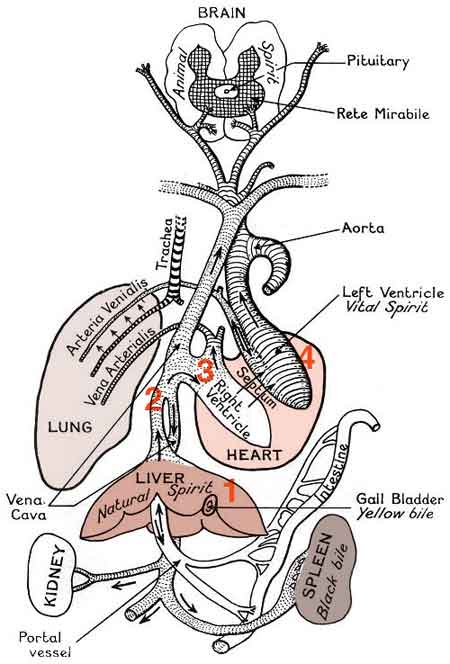
|
Romans
|
| Cicero | 106-43 BCE | statesman/orator
· wrote de Natura Deorum · popularized Greek ideas |
| Lucretius | 98-55 | poet/philosopher
· wrote de Rerum Natura · promoted reliance on reason over superstition |
| Vitruvius | fl. 1st c. BCE | architect
· wrote de Architectura |
| Frontinus | 40-103 CE | engineer
· wrote book on city water supply |
| Pliny the Elder | 23-79 | natural historian
· wrote Naturalis Historia |
 |
excerpts from
On Atoms Things that seem to us hard and stiff must be composed of deeply indented and hooked atoms and held firm by their intertangling branches. In the front rank of this class stand diamonds, with their steadfast indifference to blows. Next come stout flints and stubborn steel and bronze that stands firm with shrieking protest when the bolt is shot. Liquids, on the other hand, must owe their fluid consistency to component atoms that are smooth and round.... A third class is constituted by things that you may see dissipated instantaneously, such as smoke, clouds and flames.... On the Origin of Life I return now to the childhood of the world.... The animals cannot have fallen from the sky, and those that live on land cannot have emerged from the briny gulfs. We are left with the conclusion that the name of mother has rightly been bestowed on the earth, since out of the earth everything is born.... Whereover a suitable spot occurred, there grew up wombs, clinging to the earth by roots. These, when the time was ripe, were burst open by the maturation of the embryos, rejecting moisture now and struggling for air. Then nature directed towards that spot the pores of the earth, making it open its veins and exude a juice resembling milk, just as nowadays every female when she has given birth is filled with sweet milk because all the flow of nourishment within her is directed into the breasts.... On Growth The things you see growing merrily in stature and climbing step by step the stairs of maturity -- these are gaining more atoms than they lose.... Everything must be restored and renewed by food, and by food buttressed and sustained.... It is natural, therefore, that everything should perish when it is thinned out by the ebbing of matter.... On the Development of Sentient Matter You must admit that whatever is seen to be sentient is nevertheless composed of atoms that are insentient. The phenomena ... lead us by the hand and compel us to believe that the animate is born ... of the insentient. As a particular instance, we can point to living worms, emerging from foul dung when the earth is soaked and rotted by intemperate showers.... Nature transforms all foods into living bodies and generates from them all the senses of animate creatures.... I am not maintaining that sensations are generated automatically from all the elements out of which sentient things are created. Everything depends on the size and shape of the sense-producing atoms and on their appropriate motions, arrangements and positions.... From the fact that we perceive eggs turning into live fledglings and worms swarming out when the earth has been rotted by intemperate showers, we may infer that sense can be generated from the insentient.... |
| excerpts from
On Animals Some animals ... are engendered of beings that are not engendered themselves, and have no such origin as those above mentioned, which are produced in the spring, or at some stated period of the year. Some of these are non-productive, the salamander, for instance, which is of no sex, either male or female; a distinction also, which does not exist in the eel and the other kinds that are neither viviparous nor oviparous. The oyster also, as well as the other shell-fish that adhere to the bottom of the sea or to rocks, are of neither sex. ...Again, as to those animals which are able to engender of themselves, if they are looked upon as divided into male and female, they do engender something, it is true, by coupling, but the produce is imperfect, quite dissimilar to the animal itself, and one from which nothing else is reproduced; this we find to be the case with flies, when they give birth to maggots. This fact is better illustrated by the nature of those animals which are known as insects; a subject, indeed, very difficult of explanation, and one which requires to be treated of in a Book by itself.... On Stones Theophrastus and Mucianus are of opinion that there are certain stones which bring forth other stones. Theophrastus states, also, that a fossil ivory is found, both white and black; that the earth, too, produces bones, and that osseous stones are sometimes found. In the vicinity of Munda in Spain ... there are stones found, which, when broken asunder, bear the impression of palm leaves.... The stone called aëtites [eagle stone] has a great reputation.... It is found in the nests of eagles.... There are always two of these stones found together, they say, a male stone and a female; and without them, it is said, the various eagles that we have described would be unable to propagate.... What is there in existence more inert than a piece of rigid stone? And yet, behold! Nature has here endowed stone with both sense and hands. What is there more stubborn than hard iron? Nature has, in this instance, bestowed upon it both feet and intelligence. It allows itself, in fact, to be attracted by the magnet, and, itself a metal which subdues all other elements, it precipitates itself towards the source of an influence at once mysterious and unseen. The moment the metal comes near it, it springs towards the magnet, and, as it clasps it, is held fast in the magnet's embraces.... |
![]()
Decline of Interest in Secular
Knowledge
precursors
to "Dark" Ages (500-1000 CE)
| 391 | Alexandrian library burned |
| 476 | fall of Rome |
| 529 | Plato's Academy closed |
![]()
|
|
Goals Standardizing and Preserving Christian Dogma
Preserving and Practicing Christian Lifestyle
|

Monk at work in the Scriptorium |
|
(300 - 800 CE) |
|
|
|
|
|
| Plato |
|
|
|
| Aristotle |
|
|
|
| Lucretius |
|
(originally written in Latin) |
|
Physiologus One type of manuscript that was copied in monastery scriptoria merged secular and religious themes. Called the Physiologus, it was a collection of moral tales built upon the characteristics of animals. Some of the animals would have been familiar to most readers even if they had never personally seen one (the ant, bear, bee, cat, dog...), others were exotic or even fabulous creatures (the antelope, bonnacon, camel, gryphon, phoenix, unicorn...). Although the basic format of the Physiologus remained the same from copy to copy, individual scribes often added new animals and embellished upon the text describing them thus creating a wide array of unique documents, all with the same title. The Physiologus probably originated in the 3rd century CE, written by an author whose identity has been lost to history, and who has become known simply as Physiologus (The Naturalist). No copies of these manuscripts have been found, but the earliest that have survived include many animals native to the region around Alexandria, so it is likely that is where the first were produced. Although Physiologus can be translated "the naturalist," this type of manuscript was not intended to be an objective description of the natural world, but rather an account of its metaphysical, moral, and mystical significance. |
|
The Bern Physiologus
|
|
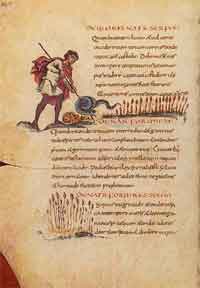 |
|
Isidore of Seville (560-636)
Wrote many treatises including:
|
|
Structure of Isidore's Etymologies (Origins)
|
|
Transmission of Greek Knowledge -- The Persian Connection |
|
|
The Nestorians From time to time, leaders in the early Christian Church gathered in what they called "ecumenical councils": meetings at which bishops from all of Christendom could consider, discuss and (it was hoped) come to universal agreement on disputed or unclear points of scripture and church doctrine. The first of these councils was held in the city of Nicaea (ny-SEE-ah) near Constantinople in 325 CE. Soon afterward, academies modeled after that in Alexandria were founded in Antioch and Nisibis. Greek served as the lingua franca for scholars at all the Alexandrian-style schools, but Syriac was the native language of students at Nisibis and many texts were translated there from Greek into Syriac. When the school moved to Edessa in 363, the Syriac tradition moved with it.
At the third council, held in Ephesus in 431 CE, delegates condemned the bishop of Constantinople, Nestorius (381-451), as a heretic for questioning Mary's status as Mother of God. Nestorius and his followers were exiled and settled in Edessa. Religous conflicts in Edessa prompted the Nestorians to move further east in 457. Around 560, the Persian leader, Khosru I, established an Alexandrian academy in Jundishapur where instruction would be conducted in Syriac.
The Bactrians For centuries after the dissolution of Alexander's empire, Greek culture continued to influence the people of Bactria. Cities like Bactra and Merv were crossroads on the Silk Road (c. 100 BCE) that helped introduce new commodities and technologies from the East, such as paper and paper-making in the 750s.
India Alexander's empire had extended to the Indus River valley. Despite the enormous distances separating Alexandria and India, communication and trade continued over the centuries via land and sea (Alexandria-Medina-Aden-Cambay; Alexandria-Antioch-Basra-Cambay).
Astronomical records from Alexandria found their way to observatories like those in Pataliputra and Ujjain. Indian astronomers added their own observations to the old but replaced the old-fashioned sexagesimal system of notation (base 60) which dated back to Babylonian times with a decimal system which included a symbol for "nothing" to help keep track of place values. They called this symbol sunya, the Hindi word meaning "the void." When this was translated into Arabic, scholars used the word sifr, meaning "empty." Italians transliterated this word as zefirum, zefiro, and zefro, which eventually became zero. |
|
|
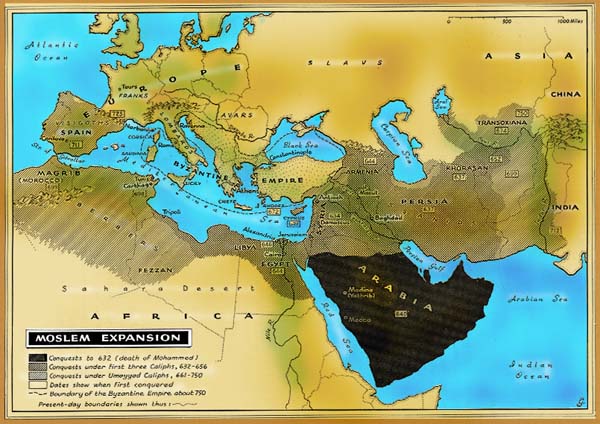
Spread of Islam from death of Mohammed (632) to 750
|
|
Al-Khwarizmi mathematician |
Baghdad |
|
|
(Ibn al Haitham) physicist |
Basra |
|
|
(Ali ibn Sina) physician |
Bokhara |
|
|
(al Buruni) philosopher, astronomer, geographer |
973-1048 Khwarazm |
|
Averroes philosopher |
Cordova |
|
|
|
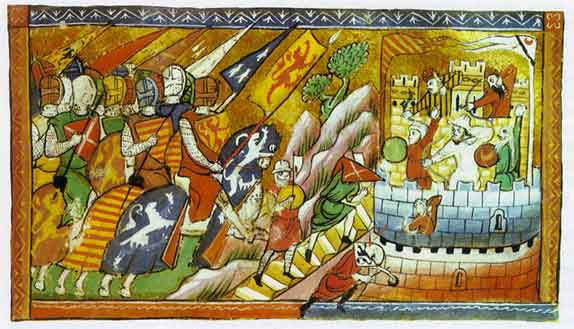
The Siege at Antioch
|
|
|
|
|
|
|
|
|
|
| Vitruvius | On Architecture | originally written in Latin |
|
| Al-Khwarizmi | Arithmetic
Trigonometry Algebra |
Adelard of Bath/Arabic
Adelard of Bath/Arabic Robert of Chester/Arabic |
|
| Al-Kindi | Perspective | Gerard of Cremona/Arabic |
|
| Alhazen | Optics | ?/Arabic |
|
| Avicenna | The Canon on Medicine | various translators/Arabic |
|
| Averroës | commentaries on Aristotle | Michael Scot/Arabic |
|
| Leonardo Fibonacci | Book of the Abacus |
|
|
| Hippocrates | various treatises | various translators/Greek & Arabic |
|
| Aristotle | various treatises | various translators/Greek & Arabic |
|
| Euclid | Elements
Optics |
Adelard of Bath/Arabic
?/Greek and Arabic |
? |
| Archimedes | complete works | William of Moerbeke/Greek |
|
| Hero of Alexandria | On Pneumatics On Reflection |
?/Greek
William of Morebeke/Greek |
13th c |
| Galen | various treatises | various translators/Greek & Arabic |
|
| Claudius Ptolemy | Almagest
Optics |
Gerard of Cremona/Arabic
Eugenius of Palermo/Arabic |
|
|
|
|
|
|
||
|

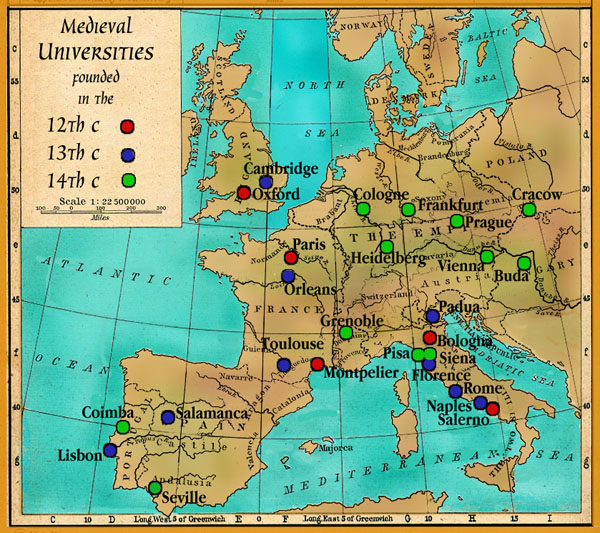

|